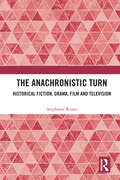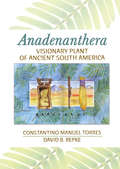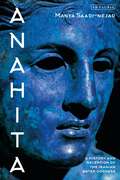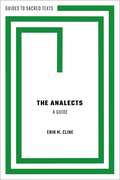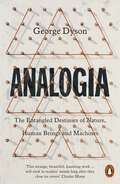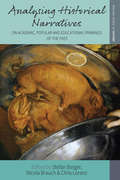- Table View
- List View
The Anachronistic Turn: Historical Fiction, Drama, Film and Television
by Stephanie RussoThe Anachronistic Turn: Historical Fiction, Drama, Film and Television is the first study to investigate the ways in which the creative use of anachronism in historical fictions can allow us to rethink the relationship between past and present. Through an examination of literary, cinematic, and popular texts and practices, this book investigates how twenty-first century historical fictions use creative anachronisms as a way of understanding modern issues and anxieties. Drawing together a wide range of texts across all forms of historical fiction - novels, dramas, musicals, films and television - this book re-frames anachronism not as an error, but as a deliberate strategy that emphasises the fictionalising tendencies of all forms of historical writing. The book achieves this by exploring three core themes: the developing trends in the twenty-first century for creators of historical fiction to include deliberate anachronisms, such as contemporary references, music, and language; the ways in which the deliberate use of anachronism in historical fiction can allow us to rethink the relationship between past and present, and; the way that contemporary historical fiction uses anachronism to better understand modern issues and anxieties. This book will appeal to students and scholars of historical fiction, contemporary historical film and television studies, and historical theatre studies.
Anadenanthera: Visionary Plant of Ancient South America
by Constantino M Torres David B RepkeA multidisciplinary study of pre-Columbian South America-centering on the psychoactive plant genus AnadenantheraAs cultures formed and evolved in pre-Columbian South America, Anadenanthera became one of the most widely used shamanic inebriants. Anadenanthera: Visionary Plant of Ancient South America is more than a comprehensive reference on shamanic visionary substances; it is a useful tool for archeologists and pre-Columbian art historians. This thorough book examines the ritual and cultural use of Anadenanthera from prehistory to the present, along with its botany, chemistry, pharmacology, anthropology, and archeology.The earliest evidence for the use of psychoactive plants in South America is provided by remains of seeds and pods recovered from archeological sites four millennia old. Various preparations were derived from it with the intent of being a shamanic inebriant. Inhaled through the nose, smoked in pipes or as cigars, and prepared in fermented drinks, Anadenanthera served a central role in the cultural development of indigenous societies in South America. Anadenanthera: Visionary Plant of Ancient South America explores the full spectrum of information gleaned from research, covering numerous archeological sites in the Andean region, as well as discussing Amazonian shamanic rituals and lore. Analyses of the artistic expressions within the decorations of associated ceremonial paraphernalia such as ritual snuffing tubes and snuff trays are included. The text is richly illustrated with photographs and images of decorated ritual implements, and provides a comprehensive bibliography.Anadenanthera: Visionary Plant of Ancient South America explores: botanical aspects, taxonomy, and geographical distribution of Anadenanthera ethnographical, historical, and traditional aspects of Anadenanthera use chemical and pharmacological investigations of the genus and the various visionary preparations derived from it-with emphasis on the biologically active constituents theories of the mechanisms of action of the active tryptamines and carboline alkaloids comparisons of wood anatomy, morphology, and percentage of alkaloid content evaluation of stylistic and iconographic traitsAnadenanthera: Visionary Plant of Ancient South America is a thorough, useful resource for archeologists, anthropologists, chemists, researchers, pre-Columbian art historians, and any layperson interested in pre-Columbian art, archeology, or visionary plants.
Anadenanthera: Visionary Plant of Ancient South America
by Constantino M Torres David B RepkeA multidisciplinary study of pre-Columbian South America-centering on the psychoactive plant genus AnadenantheraAs cultures formed and evolved in pre-Columbian South America, Anadenanthera became one of the most widely used shamanic inebriants. Anadenanthera: Visionary Plant of Ancient South America is more than a comprehensive reference on shamanic visionary substances; it is a useful tool for archeologists and pre-Columbian art historians. This thorough book examines the ritual and cultural use of Anadenanthera from prehistory to the present, along with its botany, chemistry, pharmacology, anthropology, and archeology.The earliest evidence for the use of psychoactive plants in South America is provided by remains of seeds and pods recovered from archeological sites four millennia old. Various preparations were derived from it with the intent of being a shamanic inebriant. Inhaled through the nose, smoked in pipes or as cigars, and prepared in fermented drinks, Anadenanthera served a central role in the cultural development of indigenous societies in South America. Anadenanthera: Visionary Plant of Ancient South America explores the full spectrum of information gleaned from research, covering numerous archeological sites in the Andean region, as well as discussing Amazonian shamanic rituals and lore. Analyses of the artistic expressions within the decorations of associated ceremonial paraphernalia such as ritual snuffing tubes and snuff trays are included. The text is richly illustrated with photographs and images of decorated ritual implements, and provides a comprehensive bibliography.Anadenanthera: Visionary Plant of Ancient South America explores: botanical aspects, taxonomy, and geographical distribution of Anadenanthera ethnographical, historical, and traditional aspects of Anadenanthera use chemical and pharmacological investigations of the genus and the various visionary preparations derived from it-with emphasis on the biologically active constituents theories of the mechanisms of action of the active tryptamines and carboline alkaloids comparisons of wood anatomy, morphology, and percentage of alkaloid content evaluation of stylistic and iconographic traitsAnadenanthera: Visionary Plant of Ancient South America is a thorough, useful resource for archeologists, anthropologists, chemists, researchers, pre-Columbian art historians, and any layperson interested in pre-Columbian art, archeology, or visionary plants.
Anaesthesia and the Practice of Medicine: Historical Perspectives
by Keith Sykes John P BunkerWritten by two anaesthetists, one British and one American, this unique book focuses on the transatlantic story of anaesthesia. The authors have both worked at the two hospitals where the first general anaesthetics for surgery were given in 1846, Massachusetts General Hospital in Boston, Massachusetts and University College Hospital, London. Each with more than fifty years' experience of working in anaesthesia, they combine their knowledge and expertise to offer a fresh outlook on the development of anaesthesia through the ages.This highly informative and intriguing text details the origins of anaesthesia, outlines the different techniques of anaesthesia and traces its progress with illuminating and enlightening commentaries. This is a fascinating book which considers the role key figures have played in developing anaesthesia including, Queen Victoria, William Morris, La Condamine, Bjorn Ibsen and Henry Beecher.Broken down into four sections, which are divided into easy-to-read chapters and filled with top quality photographs, this book makes compelling reading. It is recommended to all those interested in the history and development of medicine through the ages, and is of particular interest to anaesthetists. More than just the science of anaesthesia, this is the story about the people and personalities who have made anaesthesia what it is today.
Anaesthesia and the Practice of Medicine: Historical Perspectives
by Keith Sykes John P BunkerWritten by two anaesthetists, one British and one American, this unique book focuses on the transatlantic story of anaesthesia. The authors have both worked at the two hospitals where the first general anaesthetics for surgery were given in 1846, Massachusetts General Hospital in Boston, Massachusetts and University College Hospital, London. Each with more than fifty years' experience of working in anaesthesia, they combine their knowledge and expertise to offer a fresh outlook on the development of anaesthesia through the ages.This highly informative and intriguing text details the origins of anaesthesia, outlines the different techniques of anaesthesia and traces its progress with illuminating and enlightening commentaries. This is a fascinating book which considers the role key figures have played in developing anaesthesia including, Queen Victoria, William Morris, La Condamine, Bjorn Ibsen and Henry Beecher.Broken down into four sections, which are divided into easy-to-read chapters and filled with top quality photographs, this book makes compelling reading. It is recommended to all those interested in the history and development of medicine through the ages, and is of particular interest to anaesthetists. More than just the science of anaesthesia, this is the story about the people and personalities who have made anaesthesia what it is today.
Anahita: A History and Reception of the Iranian Water Goddess
by Manya Saadi-nejadAnahita was the most important goddess of pre-Islamic Iran. From her roots as an ancient Indo-European water deity her status was unrivalled by any other Iranian goddess throughout the course of three successive Iranian empires over a period of a thousand years.The first scholarly book on Anahita, this study reconstructs the Indo-European water goddess through a comparison of Celtic, Slavic, Armenian and Indo-Iranian myths and rituals. Anahita's constantly-evolving description and functions are then traced through the written and iconographic records of Iranian societies from the Achaemenid period onwards, including but not limited to the Zoroastrian texts and the inscriptions and artistic representations of the great pre-Islamic Iranian empires. The study concludes by tracing survival of the goddess in Islamic Iran, as seen in new Persian literature and popular rituals. Manya Saadi-nejad demonstrates the close relationship between Iranian mythology and that of other Indo-European peoples, and the significant cultural continuities from Iran's pre-Islamic period into the Islamic present.
Anahita: A History and Reception of the Iranian Water Goddess
by Manya Saadi-nejadAnahita was the most important goddess of pre-Islamic Iran. From her roots as an ancient Indo-European water deity her status was unrivalled by any other Iranian goddess throughout the course of three successive Iranian empires over a period of a thousand years.The first scholarly book on Anahita, this study reconstructs the Indo-European water goddess through a comparison of Celtic, Slavic, Armenian and Indo-Iranian myths and rituals. Anahita's constantly-evolving description and functions are then traced through the written and iconographic records of Iranian societies from the Achaemenid period onwards, including but not limited to the Zoroastrian texts and the inscriptions and artistic representations of the great pre-Islamic Iranian empires. The study concludes by tracing survival of the goddess in Islamic Iran, as seen in new Persian literature and popular rituals. Manya Saadi-nejad demonstrates the close relationship between Iranian mythology and that of other Indo-European peoples, and the significant cultural continuities from Iran's pre-Islamic period into the Islamic present.
The Analects (Macmillan Collector's Library #330)
by ConfuciusFormed in a time of great unrest in ancient China, The Analects is vital to an understanding of Chinese history and thought, and, 2,500 years on, it remains startlingly relevant to contemporary life.Complete and unabridged. Part of the Macmillan Collector’s Library; a series of stunning, cloth-bound, pocket-sized classics with gold foiled edges and ribbon markers. These beautiful books make perfect gifts or a treat for any book lover. Highly regarded for the poetic fluency he brings to his award–winning work, David Hinton's translation is inviting and immensely readable.Confucius, the ‘great sage’ of China, believed that an ideal society is based on humanity, benevolence and goodness. His profoundly influential philosophy is encapsulated in The Analects, a collection of sayings which were written down by his followers. Confucius advocates an ethical social order, woven together by selfless and supportive relationships between friends, families and communities. He taught that living by a moral code based on education, ritual, respect and integrity will bring peace to human society.
The Analects: A Guide (Guides to Sacred Texts)
by Erin M. ClineThe Analects (Lunyu) is the earliest and most influential record of the teachings of Kongzi (551-479 B.C.E.), known to most Westerners as "Confucius." If we measure influence according to the number of people who have lived their lives according to the teachings of a particular text, there is a good argument to be made that the Analects has been the most influential text in the world. This book argues that we have good reasons to study the Analects as a sacred text, and that doing so sheds light not only on the text and the Confucian tradition, but on what the sacred is, more broadly. It begins by examining what it means for a text to be regarded as sacred in relation to the unique history of this remarkably influential book, and goes on to offer a close study of the Analects, including its structure, its composition and compilation, and the purpose it has served in the Confucian tradition as the earliest and most authoritative record of Kongzi's teachings and conduct. The book further considers the history of the Analects as the most authoritative collection of Confucian teachings which virtually all major Confucians--as well as Chinese thinkers throughout history from the Mohist, Daoist, and Buddhist traditions--responded. This book explores the text, situating its teachings in relation to the religious practices of its time (including Zhou rituals and customs known as li and the veneration of ancestor and nature spirits), and discusses the Analects use and reception both in the periods following its composition and compilation and throughout China's imperial history up through the modern era, including the recent revival of activity in Confucian temples.
The Analects: A Guide (Guides to Sacred Texts)
by Erin M. ClineThe Analects (Lunyu) is the earliest and most influential record of the teachings of Kongzi (551-479 B.C.E.), known to most Westerners as "Confucius." If we measure influence according to the number of people who have lived their lives according to the teachings of a particular text, there is a good argument to be made that the Analects has been the most influential text in the world. This book argues that we have good reasons to study the Analects as a sacred text, and that doing so sheds light not only on the text and the Confucian tradition, but on what the sacred is, more broadly. It begins by examining what it means for a text to be regarded as sacred in relation to the unique history of this remarkably influential book, and goes on to offer a close study of the Analects, including its structure, its composition and compilation, and the purpose it has served in the Confucian tradition as the earliest and most authoritative record of Kongzi's teachings and conduct. The book further considers the history of the Analects as the most authoritative collection of Confucian teachings which virtually all major Confucians--as well as Chinese thinkers throughout history from the Mohist, Daoist, and Buddhist traditions--responded. This book explores the text, situating its teachings in relation to the religious practices of its time (including Zhou rituals and customs known as li and the veneration of ancestor and nature spirits), and discusses the Analects use and reception both in the periods following its composition and compilation and throughout China's imperial history up through the modern era, including the recent revival of activity in Confucian temples.
Analog Superpowers: How Twentieth-Century Technology Theft Built the National Security State
by Katherine C. EpsteinA gripping history that spans law, international affairs, and top-secret technology to unmask the tension between intellectual property rights and national security. At the beginning of the twentieth century, two British inventors, Arthur Pollen and Harold Isherwood, became fascinated by a major military question: how to aim the big guns of battleships. These warships—of enormous geopolitical import before the advent of intercontinental missiles or drones—had to shoot in poor light and choppy seas at distant moving targets, conditions that impeded accurate gunfire. Seeing the need to account for a plethora of variables, Pollen and Isherwood built an integrated system for gathering data, calculating predictions, and transmitting the results to the gunners. At the heart of their invention was the most advanced analog computer of the day, a technological breakthrough that anticipated the famous Norden bombsight of World War II, the inertial guidance systems of nuclear missiles, and the networked “smart” systems that dominate combat today. Recognizing the value of Pollen and Isherwood’s invention, the British Royal Navy and the United States Navy pirated it, one after the other. When the inventors sued, both the British and US governments invoked secrecy, citing national security concerns. Drawing on a wealth of archival evidence, Analog Superpowers analyzes these and related legal battles over naval technology, exploring how national defense tested the two countries’ commitment to individual rights and the free market. Katherine C. Epstein deftly sets out Pollen’s and Isherwood’s pioneering achievements, the patent questions raised, the geopolitical rivalry between Britain and the United States, and the legal precedents each country developed to control military tools built by private contractors. Epstein’s account reveals that long before the US national security state sought to restrict information about atomic energy, it was already embroiled in another contest between innovation and secrecy. The America portrayed in this sweeping and accessible history isn’t yet a global hegemon but a rising superpower ready to acquire foreign technology by fair means or foul—much as it accuses China of doing today.
Analog und Digital: schriften zur philosophie des machens
by Otl AicherOtl Aicher (1922 –1991) war einer der herausragenden Vertreter des modernen Designs, er war Mitbegründer der legendären Hochschule für Gestaltung Ulm (HfG). Der heute geläu_ ge Begriff der visuellen Kommunikation ist auf ihn zurückzuführen. Was er seit den 1950er Jahren geschaffen hat, erinnert sei z. B. an die Piktogramme für die Olympischen Sommerspiele München 1972, gehört zu den ganz großen Leistungen der visuellen Kultur unserer Zeit.Ein wesentlicher Aspekt der Arbeiten von Aicher ist deren Verankerung in einer von Denkern wie Ockham, Kant oder Wittgenstein inspirierten „Philosophie des Machens“, die die Voraussetzungen und Ziele sowie die Gegenstände und Ansprüche von Gestaltung zum Thema hat. Aichers Schriften zu Fragen des Designs von der visuellen Gestaltung bis hin zur Architektur liegen in diesem Band in geschlossener Form vor.Wenn Aicher das Analoge und Konkrete dem Digitalen und Abstrakten vorzieht, tut er dies mit philosophischer Absicht. Er relativiert die Rolle der reinen Vernunft. Er kritisiert den Rationalismus der Moderne als Ergebnis der Vorherrschaft des bloß abstrakten Denkens. Wer das Abstrakte dem Konkreten vorzieht, missversteht nicht nur die wechselseitige Abhängigkeit von Begriff und Anschauung. Er schafft nach Aichers Urteil auch eine falsche Hierarchie, eine Rangordnung, die kulturell verhängnisvoll ist. Das digitale, Abstrakte ist nicht höher, größer und wichtiger als das Analoge, Konkrete.Wilhelm Vossenkuhl
Analog und Digital: schriften zur philosophie des machens
by Otl AicherOtl Aicher (1922 –1991) war einer der herausragenden Vertreter des modernen Designs, er war Mitbegründer der legendären Hochschule für Gestaltung Ulm (HfG). Der heute geläu_ ge Begriff der visuellen Kommunikation ist auf ihn zurückzuführen. Was er seit den 1950er Jahren geschaffen hat, erinnert sei z. B. an die Piktogramme für die Olympischen Sommerspiele München 1972, gehört zu den ganz großen Leistungen der visuellen Kultur unserer Zeit.Ein wesentlicher Aspekt der Arbeiten von Aicher ist deren Verankerung in einer von Denkern wie Ockham, Kant oder Wittgenstein inspirierten „Philosophie des Machens“, die die Voraussetzungen und Ziele sowie die Gegenstände und Ansprüche von Gestaltung zum Thema hat. Aichers Schriften zu Fragen des Designs von der visuellen Gestaltung bis hin zur Architektur liegen in diesem Band in geschlossener Form vor.Wenn Aicher das Analoge und Konkrete dem Digitalen und Abstrakten vorzieht, tut er dies mit philosophischer Absicht. Er relativiert die Rolle der reinen Vernunft. Er kritisiert den Rationalismus der Moderne als Ergebnis der Vorherrschaft des bloß abstrakten Denkens. Wer das Abstrakte dem Konkreten vorzieht, missversteht nicht nur die wechselseitige Abhängigkeit von Begriff und Anschauung. Er schafft nach Aichers Urteil auch eine falsche Hierarchie, eine Rangordnung, die kulturell verhängnisvoll ist. Das digitale, Abstrakte ist nicht höher, größer und wichtiger als das Analoge, Konkrete.Wilhelm Vossenkuhl
Analogia: The Entangled Destinies of Nature, Human Beings and Machines
by George DysonHow did we end up in a world where humans coexist with technologies we can no longer fully control or understand? George Dyson plots an unexpected course through the past 300 years to reveal the hidden connections that underpin our digital age, ending with a premonition of what lies ahead. From an eighteenth-century Russian voyage across the North Pacific, to the mirror signals that heralded the age of digital telecommunications and the invention of the vacuum tube, Analogia interweaves historical adventure with scientific insight in a deeply personal story that frames the pursuit - and cost - of the digital revolution in a captivating new light.
Analogies at War: Korea, Munich, Dien Bien Phu, and the Vietnam Decisions of 1965
by Yuen Foong KhongFrom World War I to Operation Desert Storm, American policymakers have repeatedly invoked the "lessons of history" as they contemplated taking their nation to war. Do these historical analogies actually shape policy, or are they primarily tools of political justification? Yuen Foong Khong argues that leaders use analogies not merely to justify policies but also to perform specific cognitive and information-processing tasks essential to political decision-making. Khong identifies what these tasks are and shows how they can be used to explain the U.S. decision to intervene in Vietnam. Relying on interviews with senior officials and on recently declassified documents, the author demonstrates with a precision not attained by previous studies that the three most important analogies of the Vietnam era--Korea, Munich, and Dien Bien Phu--can account for America's Vietnam choices. A special contribution is the author's use of cognitive social psychology to support his argument about how humans analogize and to explain why policymakers often use analogies poorly.
Analogous and Digital
by Otl AicherOtl Aicher (1922-1991) was an outstanding personality in modern design, he was a co-founder of the legendary Hochschule fur Gestaltung (HfG), the Ulm School of Design, Germany. His works since the fifties of the last century in the field of corporate design and his pictograms for the 1972 Summer Olympics in Munich are major achievements in the visual communication of our times. "An integral component of Aicher's work is that it is anchored in a "philosophy of making" inspired by such thinkers as Ockham, Kant or Wittgenstein, a philosophy concerned with the prerequisites and aims, the objects and claims, of design. Aicher's complete theoretical and practical writings on design (which include all other aspects of visual creativity, such as architecture) are available with this new edition of the classic work. If Aicher prefers the analogous and concrete to the digital and abstract he does it with a philosophical intention. He relativizes the role of pure reason. He criticizes the rationality of Modernism as a result of the dominance of purely abstract thinking. Anyone who prefers the abstract to the concrete does not only misunderstand the mutual dependence of concept and view. In Aicher's judgement he is also creating a false hierarchy, a rank order that is culturally fatal. Things that are digital and abstract are not greater, higher and more important than things that are analogous and concrete." Wilhelm Vossenkuhl
Analogous and Digital
by Otl AicherOtl Aicher (1922-1991) was an outstanding personality in modern design, he was a co-founder of the legendary Hochschule fur Gestaltung (HfG), the Ulm School of Design, Germany. His works since the fifties of the last century in the field of corporate design and his pictograms for the 1972 Summer Olympics in Munich are major achievements in the visual communication of our times. "An integral component of Aicher's work is that it is anchored in a "philosophy of making" inspired by such thinkers as Ockham, Kant or Wittgenstein, a philosophy concerned with the prerequisites and aims, the objects and claims, of design. Aicher's complete theoretical and practical writings on design (which include all other aspects of visual creativity, such as architecture) are available with this new edition of the classic work. If Aicher prefers the analogous and concrete to the digital and abstract he does it with a philosophical intention. He relativizes the role of pure reason. He criticizes the rationality of Modernism as a result of the dominance of purely abstract thinking. Anyone who prefers the abstract to the concrete does not only misunderstand the mutual dependence of concept and view. In Aicher's judgement he is also creating a false hierarchy, a rank order that is culturally fatal. Things that are digital and abstract are not greater, higher and more important than things that are analogous and concrete." Wilhelm Vossenkuhl
Analyse und Vergleich politischer Mythen: Ein systematischer Theorierahmen für Demokratien und Autokratien
by Dennis Bastian RudolfZiel dieses Buches von Dennis Bastian Rudolf ist es, einen systematischen Theorie- und Analyserahmen des politischen Mythos für Demokratien und Autokratien zu entwickeln. Der Autor widmet sich zunächst den zentralen Merkmalen dieses Phänomens und richtet diese auf die Anforderungen einer vergleichenden Analyse aus, um davon ausgehend eine theoretisch-konzeptionelle Einordnung des politischen Mythos in zentrale Theorien und Konzepte der Vergleichenden Politikwissenschaft zu vollziehen. Potentiale hinsichtlich der Anschlussfähigkeit und des Mehrwerts einer solchen Herangehensweise werden abschließend im Sinne einer machtsensiblen Perspektive politischer Kulturforschung im Kontext von Deutungsmacht gebündelt und explorativ für unterschiedliche politische Regimetypen systematisiert.
Analyses Concerning Passive and Active Synthesis: Lectures on Transcendental Logic (Husserliana: Edmund Husserl – Collected Works #9)
by Edmund HusserlComing from what is arguably the most productive period of Husserl's life, this volume offers the reader a first translation into English of Husserl's renowned lectures on `passive synthesis', given between 1920 and 1926. These lectures are the first extensive application of Husserl's newly developed genetic phenomenology to perceptual experience and to the way in which it is connected to judgments and cognition. They include an historical reflection on the crisis of contemporary thought and human spirit, provide an archaeology of experience by questioning back into sedimented layers of meaning, and sketch the genealogy of judgment in `active synthesis'. Drawing upon everyday events and personal experiences, the Analyses are marked by a patient attention to the subtle emergence of sense in our lives. By advancing a phenomenology of association that treats such phenomena as bodily kinaesthesis, temporal genesis, habit, affection, attention, motivation, and the unconscious, Husserl explores the cognitive dimensions of the body in its affectively significant surroundings. An elaboration of these diverse modes of evidence and their modalizations (transcendental aesthetic), allows Husserl to trace the origin of truth up to judicative achievements (transcendental logic). Joined by several of Husserl's essays on static and genetic method, the Analyses afford a richness of description unequalled by the majority of Husserl's works available to English readers. Students of phenomenology and of Husserl's thought will find this an indispensable work.
Analyses of Aristotle (Jaakko Hintikka Selected Papers #6)
by Jaakko HintikkaAristotle thought of his logic and methodology as applications of the Socratic questioning method. In particular, logic was originally a study of answers necessitated by earlier answers. For Aristotle, thought-experiments were real experiments in the sense that by realizing forms in one's mind, one can read off their properties and interrelations. Treating forms as independent entities, knowable one by one, committed Aristotle to his mode of syllogistic explanation. He did not think of existence, predication and identity as separate senses of estin. Aristotle thus serves as an example of a thinker who did not rely on the distinction between the allegedly different Fregean senses, thereby shedding new light on our own conceptual presuppositions. This collection comprises several striking interpretations that Jaakko Hintikka has put forward over the years, constituting a challenge not only to Aristotelian scholars and historians of ideas, but to everyone interested in logic, epistemology or metaphysics and in their history.
Analysing Historical Mathematics Textbooks (International Studies in the History of Mathematics and its Teaching)
by Gert SchubringThis book is about the creation and production of textbooks for learning and teaching mathematics. It covers a period from Antiquity to Modern Times. The analysis begins by assessing principal cultures with a practice of mathematics. The tension between the role of the teacher and his oral mode, on the one hand, and the use of a written (printed) text, in their respective relation with the student, is one of the dimensions of the comparative analysis, conceived of as the ‘textbook triangle’. The changes in this tension with the introduction of the printing press are discussed. The book presents various national case studies (France, Germany, Italy) as well as analyses of the internationalisation of textbooks via transmission processes. As this topic has not been sufficiently explored in the literature, it will be very well received by scholars of mathematics education, mathematics teacher educators and anyone with an interest in the field.
Analysing Historical Narratives: On Academic, Popular and Educational Framings of the Past (Making Sense of History #40)
by Stefan Berger Chris Lorenz Nicola BrauchFor all of the recent debates over the methods and theoretical underpinnings of the historical profession, scholars and laypeople alike still frequently think of history in terms of storytelling. Accordingly, historians and theorists have devoted much attention to how historical narratives work, illuminating the ways they can bind together events, shape an argument and lend support to ideology. From ancient Greece to modern-day bestsellers, the studies gathered here offer a wide-ranging analysis of the textual strategies used by historians. They show how in spite of the pursuit of truth and objectivity, the ways in which historians tell their stories are inevitably conditioned by their discursive contexts.
Analysing Historical Narratives: On Academic, Popular and Educational Framings of the Past (Making Sense of History #40)
by Chris Lorenz Stefan Berger, Nicola BrauchFor all of the recent debates over the methods and theoretical underpinnings of the historical profession, scholars and laypeople alike still frequently think of history in terms of storytelling. Accordingly, historians and theorists have devoted much attention to how historical narratives work, illuminating the ways they can bind together events, shape an argument and lend support to ideology. From ancient Greece to modern-day bestsellers, the studies gathered here offer a wide-ranging analysis of the textual strategies used by historians. They show how in spite of the pursuit of truth and objectivity, the ways in which historians tell their stories are inevitably conditioned by their discursive contexts.
Analysing Historical Narratives: On Academic, Popular and Educational Framings of the Past (Making Sense of History #40)
by Stefan Berger, Nicola Brauch Chris LorenzFor all of the recent debates over the methods and theoretical underpinnings of the historical profession, scholars and laypeople alike still frequently think of history in terms of storytelling. Accordingly, historians and theorists have devoted much attention to how historical narratives work, illuminating the ways they can bind together events, shape an argument and lend support to ideology. From ancient Greece to modern-day bestsellers, the studies gathered here offer a wide-ranging analysis of the textual strategies used by historians. They show how in spite of the pursuit of truth and objectivity, the ways in which historians tell their stories are inevitably conditioned by their discursive contexts.
